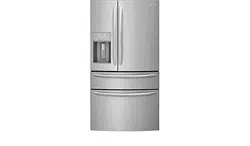Documents: Go to download!
User Manual
- Owner's manual - (English)
- FEATURES AT A GLANCE
- INSTALLATION
- DOOR REMOVAL INSTRUCTIONS
- DOOR REMOVAL INSTRUCTIONS
- INSTALLING DOOR HANDLES
- CONNECTING THE WATER SUPPLY
- USING THE DISPLAY
- USING THE DISPENSER
- STORAGE FEATURES
- STORING FOOD AND SAVING ENERGY
- NORMAL OPERATING SOUNDS AND SIGHTS
- CHANGING THE FILTER
- CARE & CLEANING
- BEFORE CALLING
Table of contents
User manual French door Refrigertor.

FEATURES AT A GLANCE
*Features may vary according to model

INSTALLATION
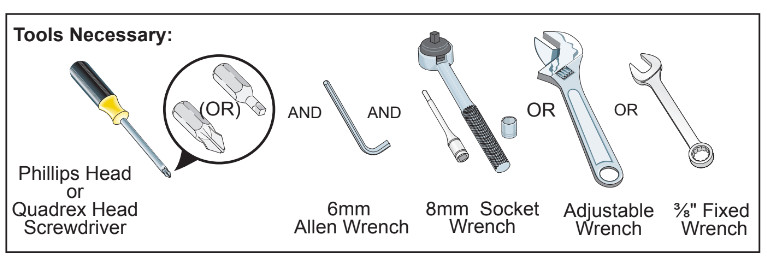
This Use & Care Guide provides general installation and operating instructions for this model. We recommend using a service or kitchen contracting professional to install the refrigerator. Use the refrigerator only as instructed in this Use & Care Guide. Before starting the refrigerator, follow these important first steps.
1. Installation
Allow the following clearances for ease of installation, proper air circulation, and plumbing and electrical connections: Sides & Top 3⁄8 inch (9.5 mm) Back 1 inch (25.4 mm).
Note: If the refrigerator is placed with the door hinge side against a wall, allow additional space so the door can be opened wider.
2. Location
• Choose a place that is near a grounded, non-GFCI, electrical outlet. Do Not use an extension cord or an adapter plug.
• If possible, place the refrigerator out of direct sunlight and away from the range, dishwasher, or other heat sources.
• The refrigerator must be installed on a floor that is level and strong enough to support a fully loaded refrigerator.
• Consider water supply availability for models equipped with an automatic ice maker.
CAUTION: Do Not install the refrigerator where the temperature will drop below 55°F (13°C) or
rise above 110°F (43°C). The compressor will not be able to maintain proper temperatures inside the refrigerator.
3. Door opening
The refrigerator should be positioned to allow easy access to a counter when removing food. For best use of refrigerator drawers and freezer baskets, the refrigerator should be in a position where both can be fully opened.
4. Cabinet Leveling & Refrigerator Door Alignment (if necessary)
Guidelines for final positioning of refrigerator:
See other models: FPBC2278UF FFTR2021TW FFTR1814TS FGTR1837TP FFHT1425VW
• All four corners of the cabinet must rest firmly on the floor.
• The front should be slightly elevated to ensure that doors close and seal properly.
• Doors should align with each other and be level.
Most of these conditions can be met by raising or lowering the adjustable anti-tip legs.
To level the cabinet using the anti-tip legs:
- Slightly open freezer drawer.
- Lower anti-tip legs until they are both
touching the floor. Use a pair of pliers to
adjust.
To raise unit: turn leg clockwise.
To lower unit: turn leg counterclockwise.
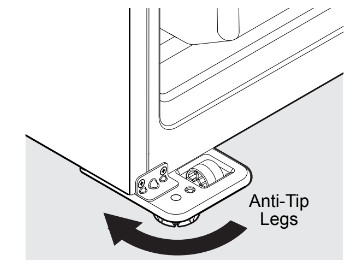
- Ensure both doors are bind-free with their seals touching the cabinet on all four sides and that cabinet is stable.
To make final door height adjustments:
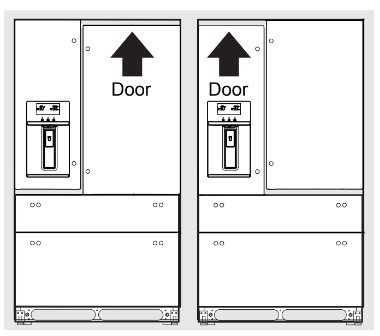
- Open Custom-Flex Temp drawer to make lower hinge visible.
- Insert 6mm AllenTM wrench into the shaft of the lower hinge.
To lower unit: turn adjustment screw clockwise.
To raise unit: turn adjustment screw counterclockwise.
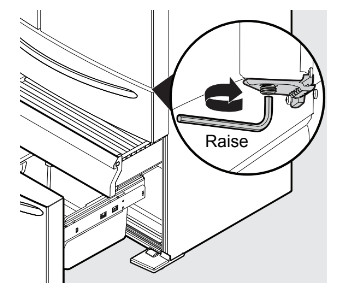
5. Flipper Mullion
Adjust Flipper Mullion for proper connection with the mullion guide by ensuring the flipper mullion is folded and perpendicular to the fresh food door. If the mullion guide is not in the correct position, it could prevent the door from closing completely.
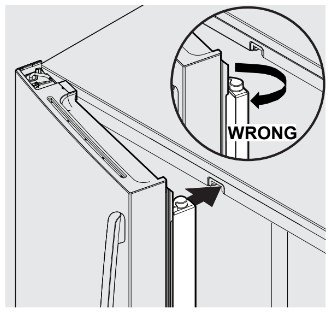
DOOR REMOVAL INSTRUCTIONS
Getting through narrow spaces: If refrigerator will not fit through an entrance area, doors can be removed. Check first by measuring the entrance.
To prepare for removing the doors:
1. Make sure the electrical power cord is unplugged from the wall outlet.
2. Remove any food from the door shelves and close the doors.
To remove the refrigerator doors:
1. Open doors to 90°.
2. Remove all five PhillipsTM screws from top hinge cover and lift up.
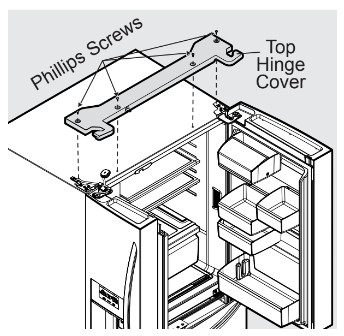
3. Trace lightly around the door’s top hinges with a pencil. This makes reinstallation
easier.
4. Disconnect electrical harness running from door to hinge cover.

5. Pull up on water line gently to remove from door.

NOTE:
- Use care while pulling the water tube from the door to be sure that tube does not kink.
- Approximately four feet of water tube will be pulled from the refrigerator door.
CAUTION: Be sure doors are set aside in a secure position where they cannot fall and cause personal injury, or damage to the doors or handles.
6. Remove three 8mm bolts from both top hinges. Lift doors up off lower hinges and carefully set aside.
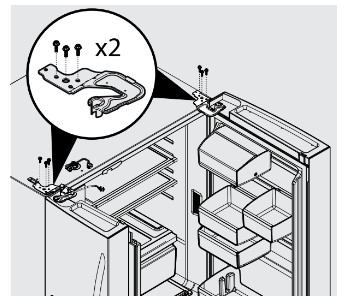
7. To gain access to lower hinge, drawer will need to be extended. Unscrew the three lower hinge screws and slide the hinge inwards.
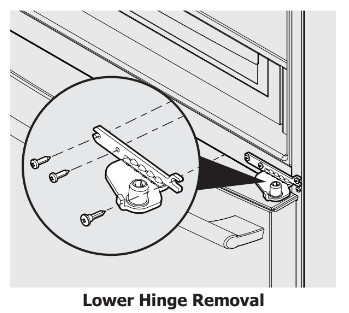
8. To reinstall doors, reverse procedure.
IMPORTANT: Make sure water line tubing goes through hole at top of dispenser pocket. There is also a metal wrap on the tubing to prevent dam- age from the hinge rubbing against it. This needs to be fixed back around the tube in the proper location upon reinstallation (just as long as the tube is protected from the hinge).
NOTE: When reinserting the water tube and replac-ing the top hinge cover, use care to be sure the tube does not kink.
Once both doors are in place, ensure they are aligned with each other and level (Reference the Installation section for more details), and replace the top hinge cover.
To remove the Custom-FlexTM Temp Drawer
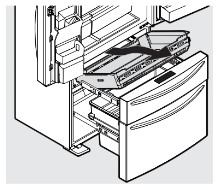
1 Fully open drawer.
2 Remove basket from drawer.
3 Unsnap the 4 cable ties by pressing clip sides together and pushing through opening.
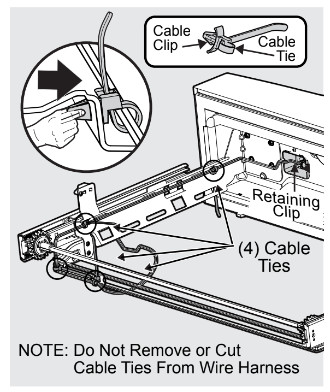
4 Remove screw and retaining clip and disconnect the harness

5 Remove drawer by pressing on the liner clips and slide rail past clips on both sides to fully remove drawer from cabinet.
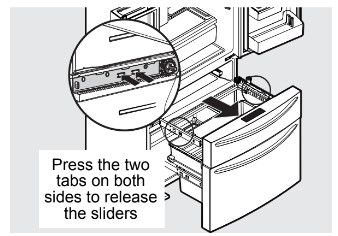
DOOR REMOVAL INSTRUCTIONS
Reinstalling the Custom-FlexTM Temp Drawer
1 Place drawer with brackets and sliders inside compartment and click sliders into place on each side.
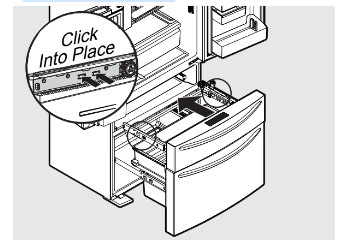
2 Reconnect cabinet harness.
3 Replace retaining clip and secure with screw.

4 Reattach electrical harness by positioning the cable clips over the black markings on the harness and push the 4 cable clips through openings in rail to secure harness in place.
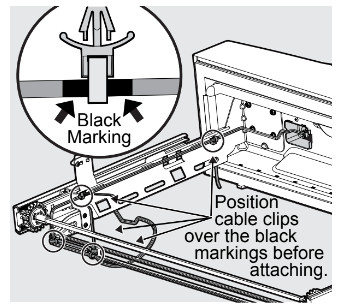
5 Slide basket into place.
6 Close drawer.
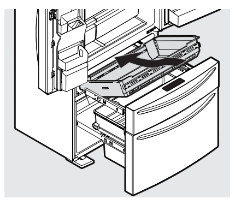
Removing Freezer Drawer
CAUTION: Drawer is heavy. Use caution when lifting.
1 Open drawer and fully extend.
2 Remove the freezer drawer.
3 Remove the freezer basket.
4 Inside the cabinet, press the two tabs on both sides to release the sliders.
5 Remove the drawer with brackets and sliders.
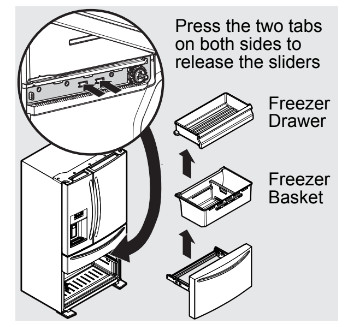
Reinstalling Freezer Drawer
1 Place drawer with brackets and sliders inside the cabinet and click into place.
2 Replace the basket.
NOTE: For additional instructions, see Storage. Features section.
INSTALLING DOOR HANDLES
CAUTION: Wear gloves and safety goggles. Use extreme CAUTION when installing these handles.
Door Handle Mounting Instructions
1 Remove handles from carton and any other protective packaging.
2 Position fresh food handle end caps over upper and lower pre-installed shoulder bolts (A) that are fastened into door, ensuring the holes for the set screws are facing towards the opposite door.
3 While holding handle firmly against door, fasten upper and lower Allen set screws (B) with supplied Allen wrench.
4 Repeat steps 2 and 3 to install opposite handle. Ensure the holes for the set screws are facing towards the first door.
5 Position freezer/Custom-FlexTM Temp Drawer handle end caps over left and right pre-installed shoulder bolts (A) that are fastened to the door, ensuring the holes for the set screws are facing down.
6 While holding handle firmly against door, loosely tighten right Allen set screw (B) with supplied Allen wrench until there is no gap between handle and door.
7 Still holding the handle firmly to the door, firmly tighten left Allen set screw (B) with supplied Allen wrench.
8 Return to the right Allen set screw (B) and firmly tighten with supplied Allen wrench.
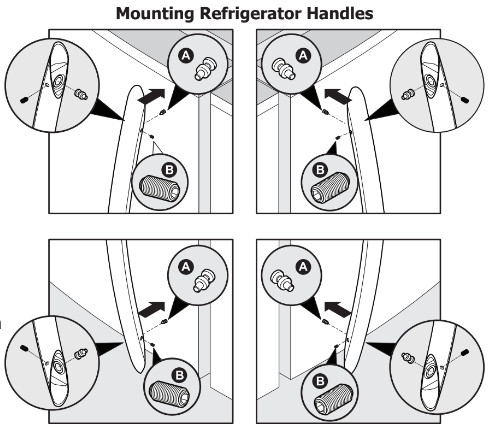
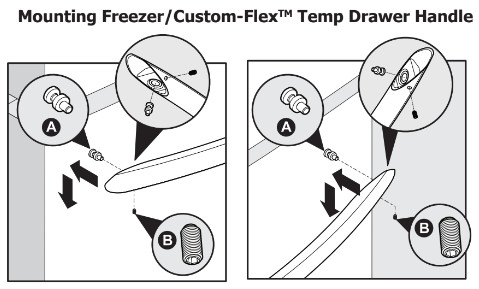
NOTE:
- When tightening the Allen set screws, it is imperative that force be applied to the longer arm of the Allen wrench sup-plied in the handle packaging.
- All set screws should be tightened so the screw is below the surface of the handle. The handles should be drawn tight to doors/drawer with no gaps. Opening the opposite door while tightening the Allen screw makes installation easier.
- The door handle may loosen over time or if it was installed improperly. If this happens,
tighten the set screws on the handles.
CONNECTING THE WATER SUPPLY
WARNING:
To avoid electric shock, which can cause death or severe personal injury, disconnect the refrigerator from electrical power before connecting a water supply line to the refrigerator.
CAUTION
To Avoid Property Damage:
• Copper or Stainless Steel braided tubing is recommended for the water supply line. Water supply tubing made of 1⁄4 inch plastic is not recommended to be used. Plastic tubing greatly increases the potential for water leaks, and the manufacturer will not be responsible for any damage if plastic tubing is used for the supply line.
• DO NOT install water supply tubing in areas where temperatures fall below freezing.
• Chemicals from a malfunctioning water softener can damage the ice maker. If a water softening system is present, ensure the softener is maintained and working properly.
IMPORTANT
Ensure that the water supply line connec-tions comply with all local plumbing codes.
To install the water supply line, the following are needed:
• Basic Tools: adjustable wrench, flat-blade screwdriver, and PhillipsTM screwdriver
• Access to a household cold water line with water pressure between 30 and 100 psi.
• A water supply line made of 1⁄4 inch (6.4 mm) OD, copper or stainless steel tubing. To determine the length of tubing needed, measure the distance from the ice maker inlet valve at the back of the refrigerator to the cold water pipe. Then add approximately 7 feet (2.1 meters), so the refrigerator can be moved out for cleaning.
• A shutoff valve to connect the water supply line to the household water system. DO NOT use a self piercing type shutoff valve.
• Do not re-use compression fitting or use thread seal tape.
• A compression nut and ferrule (sleeve) for connecting a copper water supply line to the ice maker inlet valve.
NOTE:
Expect the first ice harvest within first 24 hours of unit operation. To prevent any is-sues concerning ice production, please ensure that all water lines are primed. See “Priming the water supply system” in the “AUTOMATIC ICE & WATER DISPENSER” section.
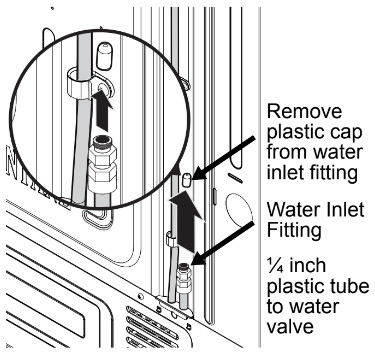
IMPORTANT
The refrigerator’s water supply system includes several tubing lines, a water filter, and a water valve. To ensure that the water dispenser works properly, this system must be complete-ly filled with water when the refrigerator is first connected to the household water supply line.
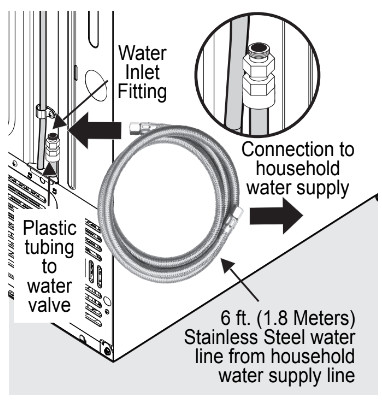
To Connect Water Tube to Household Water Supply

1 Disconnect refrigerator from electrical power source.
2 Place end of water supply line into sink or bucket. Turn ON water supply and flush supply line until
water is clear. Turn OFF water supply at shutoff valve.
3 Remove plastic cap from water inlet fitting and discard cap.
4 If using (recommended) stainless steel braided tubing - the nut and ferrule are already assembled on the tubing. Slide compression nut onto water inlet fitting and finger tighten.
5 Using two adjustable wrenches (one to hold the household water line nut and the other to hold the water inlet fitting nut), tighten a half turn with wrench. DO NOT over tighten.
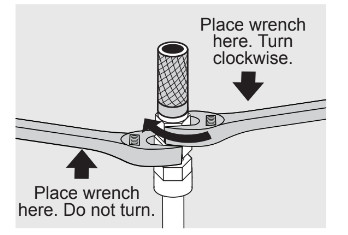
6 Turn ON water supply at shutoff valve and tighten any connections that leak.
7 Reconnect refrigerator to electrical power source.
8 Ensure ice maker is turned ON.
9 Purge air from Ice & Water Dispenser System.
USING THE DISPLAY
Display
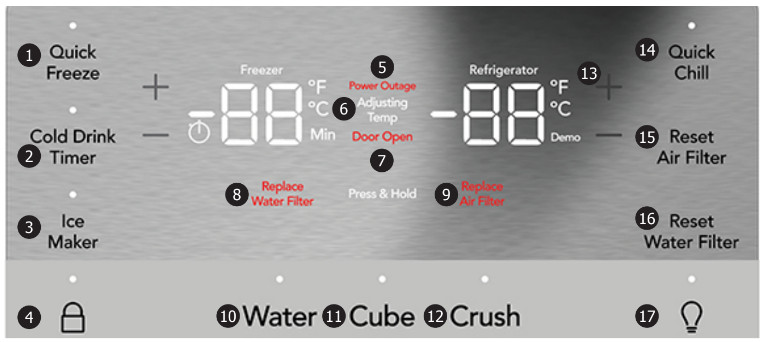
Sleep mode-Display
Sleep mode is default on. When sleep mode is on, the the LED’s are not illuminated on the
display. Sleep mode can be changed to have the display on full time. While in Sleep mode
pressing any key will illuminate LED’s and then go back to sleep after a short time. To turn sleep mode On/Off, press and hold for 5 seconds “Crush” and “ Light” simultaneously. Tone will confirm.
 Quick Freeze (on/off)
Quick Freeze (on/off)
Activates a faster rate for freezing food in the freezer. Use this feature when loading several items into the freezer at one time. Automatically deactivates after 12 hours.
 Cold Drink Timer
Cold Drink Timer
Quickly chills a drink inside the freezer compartment. To enable, touch the appear on the freezer temp display (in minutes) and can be changed using the +/- buttons. A tone will sound when the
time has been input. Range is from 20- 45 minutes in 5 minute intervals. Drinks will freeze if temperature setting is too low or timer setting is too long.
WARNING
When using the cold drink timer, make sure to remove drinks from freezer compartment when alarm sounds. Carbonated drinks may explode if left in freezer for too long.
 Ice Maker
Ice Maker
Press and hold for 3 seconds to turn ice maker on/off. When indicator is lit, ice maker is on. When indicator is not lit, ice maker is in the OFF state and will stop making ice. While off, ice dispensing can continue as long as there is ice in the bucket. When ice maker is off and ice is dispensing, indicator will blink.

The lock button can be used to lock the display preventing it from being used in certain situations. Press and hold for 3 seconds to enable/disable. While in the locked state, no changes can be made
to settings on the display. Dispensing ice and water will be disabled. The indicator will flash and an audible warning tone is played.
 Power Outage
Power Outage
In the event of a power failure, the power outage alert will be illuminated once power has been restored and a tone will sound. The alert will only be illuminated if the refrigerator or freezer reached unsafe temperatures during the outage. Press any button to silence the tone.

Adjusting Temp
Illuminates when temperatures are changed on the display and will remain illuminated until the desiredtemperatures are reached inside the refrigerator and freezer. Press either the + or - to adjust to desired temperature setting.
Freezer temp
Control temperatures range from -6°F / -21°C to +6°F / -15°C.
Refrigerator temp
Control temperatures range from +34°F / +1°C to +44°F / +7°C. This unit is designed to operate at 37°F. Refrigerator/0°F Freezer. Unit should stabilize temperatures within 24 hours of installation.
 Door Open
Door Open
Illuminates whenever the doors are open. If a door is left open for 5 minutes or more, an alarm will sound and the display will be illuminated until the doors are shut. Pressing any button will mute the alarm temporarily. Check to make sure no food is blocking the doorway.
 Replace Water Filter
Replace Water Filter
Display illuminates every 6 months or when filter needs replacing. Replace filter and then press and hold ‘Reset Water Filter’ for 3 seconds to deactivate warning on display. See “Replacing the Filter” section for more information.
 Replace Air Filter
Replace Air Filter
Display illuminates every 6 months or when filter needs replacing. Replace filter and then press and hold ‘Reset Air Filter’ for 3 seconds to deactivate warning on display. See “Replacing the Filter” section for more information.
 Water
Water
Press the “water” key to dispense water. An indicator light will be illuminated above the active feature.
 Cube
Cube
Press the “cube” key to dispense cubed ice. An indicator light will be illuminated above the active feature.
 Crush
Crush
Press the “crush” key to dispense crushed ice. An indicator light will be illuminated above the active feature.
 °F/°C
°F/°C
To toggle between Fahrenheit (°F) and Celsius (°C), simultaneously press and hold + and - for 5 seconds on refrigerator side of display.
 Quick Chill
Quick Chill
Quick chill is a faster rate for chilling food in the refrigerator compartment. Use this feature when loading several items into the refrigerator at one time. Deactivates after 6 hours.
 Reset Air Filter
Reset Air Filter
After replacing filter, press and hold for 3 seconds to reset.
 Reset Water Filter
Reset Water Filter
After replacing filter, press and hold for 3 seconds to reset.

Toggles dispenser light On and Off.
Setting temperatures
NOTE: The recommended settings for a product in-
stalled in a kitchen is 37 ̊F for the fresh food compartment and 0 ̊F for the freezer.
IMPORTANT:
- If food is freezing in the fresh food compart-ment, increase the temperature setting 1 or 2 degrees.
- Food placed within 1 inch in front of the air ports may cause food to freeze.

Note:
- Unit should stabilize temperatures within 24 hours of installation.
- Control features and alarms may vary by model.
Alarms
Power Outage
In the event of a power failure, the power outage alert will be illuminated once power has been restored and a tone will sound. The alert will only be illuminated if the refrigerator or freezer reached unsafe temperatures during the outage. Press any button to silence the tone.
Water Filter
When illuminated, the water filter needs to be replaced. Change the water filter every 6 months or when 120 gallons of water has been dispensed. To reset, press and hold button for 3 seconds. Tone will sound once it has been reset.
Air Filter
When illuminated, air filter needs to be re-placed. Change the air filter every 6 months. To reset, press and hold button for 3 seconds. Tone will sounds once it has been reset.
Door
If a door has been left open for five minutes or more, an alarm will sound and the door open
indicator will illuminate on the display. The alarm can be turned off by closing the door or
pressing any key. Control panel will return to normal operations after the door is closed.
Error Tone
An alarm will sound if the user tries to make a selection that is not available.
Sabbath Mode
- The Sabbath Mode is a feature that disables portions of the refrigerator and its controls in accordance with observance of the weekly Sabbath and religious holidays within the Orthodox Jewish community.
- Sabbath Mode is turned ON and OFF by simultaneously pressing and holding both the “-” (freezer side) and “+” (refrigerator side) for five seconds. Other than the High Temp alarm, no audible sounds will occur until the user exits the Sabbath mode. The display shows “Sb” while in Sabbath mode.
- In the Sabbath Mode, the High Temp alarm is active for health reasons. For example, if the door is left ajar the High Temp alarm is activated. The refrigerator will function normally once the door is closed, without any violation of the Sabbath/Holidays. The High Temp alarm is permitted when cabinet temperature is outside the safe zone for 20 minutes. The alarm silences itself after 10 minutes while the High Temp icon stays lit until the Sabbath mode is exited.
NOTE:
-
While in Sabbath Mode, neither the lights, dispenser, nor the control panel will work
until Sabbath Mode is deactivated. Refrigerator stays in Sabbath Mode after power failure recovery. It must be deacti-vated with the buttons on the control panel. -
Although the Sabbath Mode has been initi-ated, the ice maker will complete the cycle it had already started. The ice cube compart-ment will remain cold and new ice cubes can be made with standard trays.
USING THE DISPENSER
Using the ice maker after installation
Before making ice for the first time, be sure to prime the water supply system. Air in new plumbing lines can result in two or three empty ice maker cycles. Furthermore, if the system is not flushed, the first ice cubes may be discolored or have an odd flavor.
Priming the water supply system
*CAUTION: For proper dispenser operation, recommended water supply pressure should fall between 30 psi and 100 psi. Excessive pressure may cause the system to malfunction.
1 Begin filling the system by pressing and holding a drinking glass against the
dispenser.
2 Keep the glass in this position until water comes out of the dispenser. It may take
about 11⁄2 minutes.
3 Continue dispensing water for about four minutes to flush the system and plumbing connections of any impurities (stopping to empty the glass as necessary).

Dispenser
NOTE:
- The water dispenser has a built-in device that shuts off the water flow after two min-utes of continuous use. To reset this shutoff device, simply release the dispenser paddle.
- After the initial 26 ounces (750 ml), water will remain room temperature until the tank
has refilled and been given enough time to chill the next 26 ounces (750 ml) of water. May take up to 8 hours to chill.
Ice maker operation & care
After the refrigerator is installed properly and has cooled for several hours, the ice maker can produce ice within 24 hours. The ice maker will fill the ice bin from the rear. Dispense some ice to force the ice forward in the bin. This will allow the bin to fill completely.
Ice Maker and Storage Bin Capacity
This ice maker should produce 2 to 3 pounds of ice per 24 hours. The ice bin will hold about 4 pounds of ice.
Turning the fresh food ice maker on and off
IMPORTANT: The ice maker is turned on at the factory so it can work as soon as the refrigerator is installed. If it is not possible to connect a water supply, set the ice maker’s On/Off feature to Off; otherwise, the ice maker’s fill valve may make a loud chattering noise when it attempts to operate without water.
Ice production is controlled by the ice maker’s On/Off feature on the control panel. Pressing the On/Off feature turns the ice maker on & off.
NOTE: The ice maker also has a built-in plastic signal arm that automatically stops ice pro-
duction when the ice bin is full. This signal arm should not be used to manually stop the ice maker.
IMPORTANT
- Turning off the ice maker simply disables ice making. Existing ice can still be dispensed, and water can be dispensed.
- On occasion, unusually small ice cubes may be noticed in the bucket or in dispensed ice. This could occur in normal operation of the ice maker. If happening frequently, it may be an indication of low water pressure or the water filter needs to be replaced. As the wa-ter filter nears the end of its useful life and becomes clogged with particles, less water is delivered to the ice maker during each cycle. Remember, if it’s been six months or longer since last changing the water filter, replace it with a new one. Poor quality household water may require the filter to be changed more frequently.
CAUTION: If the water supply to the refrigerator is softened, be sure the softener is properly
maintained. Chemicals from a water softener can damage the ice maker.
Ice maker/dispenser tips
• If refrigerator is not connected to a water supply or the water supply is turned off, turn off the ice maker as described in the previous section.
• The following sounds are normal when the ice maker is operating:
- Motor running
- Ice dropping into ice bin
- Water valve opening or closing
- Running water
• If a large quantity of ice is needed at one time, it is best to get cubes directly from the ice bin.
• Ice cubes stored too long may develop an odd flavor. Empty the ice bin as explained
below.
• When dispensing cubed ice, it is normal to have a small quantity of little pieces along with the whole cubes.
• To avoid splashing, dispense ice into the container before adding liquids.
• It is normal for ice to fill to the top of the ice bin.
Cleaning the ice maker
Clean the ice maker and ice bin at regular intervals, especially prior to vacation or moving.
1 Turn off the ice maker.
2 Remove the ice bin by lifting upward and pulling straight out.
3 Empty and carefully clean the ice bin with mild detergent. Do not use harsh or abrasive cleaners. Do not place in dishwasher. Rinse with clear water.
4 Allow the ice bin to dry completely before replacing in the freezer.
5 Replace the ice bin. Turn the ice maker on.
Remove and empty the ice bin if:
• An extended power failure (one hour or longer) causes ice cubes in the ice bin to melt and refreeze together after power is restored, jamming the dispenser
mechanism.
• Ice dispenser is used infrequently. Ice cubes will freeze together in the bin, jamming the dispenser mechanism.
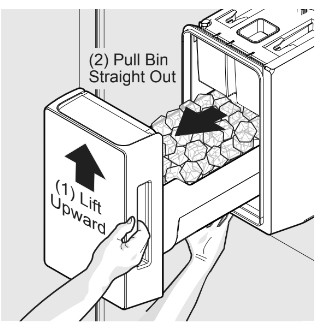
Removing Ice Bin: Remove the ice bin by (1) lifting upward and (2) pulling straight out, then shake to loosen the cubes or clean as explained above.
CAUTION:
- NEVER use an ice pick or similar sharp instrument to break up the ice. This could damage the ice bin and dispenser mechanism.
- To loosen stuck ice, use warm water. Before replacing the ice bin, make sure it is completely dry.
IMPORTANT: When removing or replacing the ice bin, avoid rotating the auger in the ice bin. If
the auger is accidentally rotated, realign the auger by turning it in 45 degree turns (see below) until the ice bin fits into place with the drive mechanism. If the auger is not properly aligned when replacing the ice bin, the refrigerator will not dispense ice. The fresh food door also may not close properly causing warm air to leak into the fresh food compartment.

STORAGE FEATURES
CAUTION: To avoid personal injury or property damage, handle tempered glass shelves carefully. Shelves may break suddenly if nicked, scratched, or exposed to sudden temperature change. Allow the glass shelves to stabilize to room temperature before cleaning. Do not wash in dishwasher.
NOTE: Features may vary according to model.
Shelf positions can easily be adjusted in the fresh food compartments as needed. The shelves have mounting brackets that attach to slotted supports at the rear of each compartment.
Change the Position of a Shelf
1 Remove all food from shelf.
2 Lift the front edge up and pull the shelf out.
3 Replace by inserting the mounting bracket hooks into the desired support slots.
4 Lower the shelf and lock into position.
To adjust flip shelf:
1 Remove food from shelf.
2 Lift the right side edge of shelf upwards and push to the left towards ice maker.

To adjust slide-under/flip shelf:
1. Push front half shelf backward towards rear of cabinet until the rear half shelf drops down, then gently continue pushing front half shelf back and under the rear half shelf.
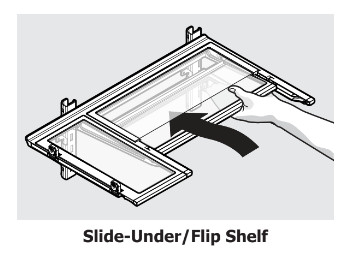
2. With front half fully below back half, lift front of shelf to flip it upwards toward the back of the cabinet.
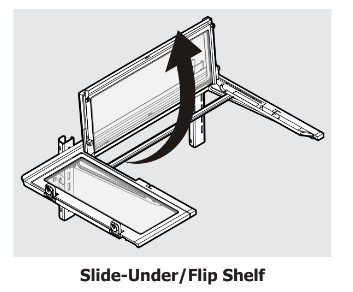
Drawers
The refrigerator includes a variety of storage drawers.
Auto CrispSeal Drawer (with automatic humidity control)
Crisper drawers are designed for storing fruits, vegetables, and other fresh produce. Crispers have an auto humidity control on the side of each crisper under the humidity control cover.
To remove the auto humidity control membrane for cleaning:
1 Reach to back of humidity control cover.
2 Pull up on cover.
3 Pull cover towards back of cabinet and remove.
4 Clean humidity membrane with hot soapy water.
5 Replace membrane and cover by reversing the steps above. Repeat for both crispers.
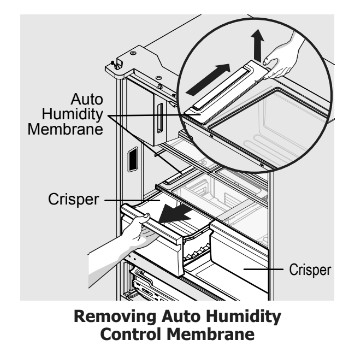
NOTE: Frigidaire does not recommend replacing the auto-humidity membrane unless it becomes
damaged or ruined. If the membrane becomes soiled, it can be washed with soap and water. Ensure membrane is dry before replacing in unit.
To remove the Auto CrispSeal drawer for cleaning:
1 Pull the drawer out until it stops.
2 Lift the front slightly and remove the drawer.
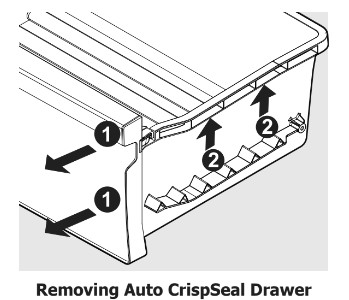
SnackZone - Recessed Snack Drawers
These drawers are ideal for storage of deli meats and cheeses.
To open: slide back the cover to allow access to the drawers.
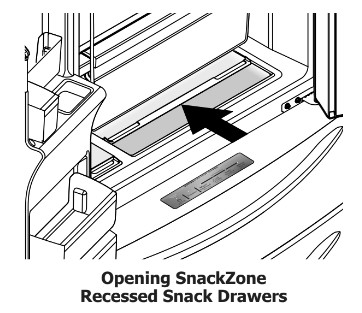

IMPORTANT: Do not use the Custom-Flex Temp Drawer to store fresh produce as these items may
freeze and cause damage to the fruits and leafy vegetables stored in the drawer.
Using Your Custom-FlexTM Temp Drawer Controls
 The drawer automatically defaults to a locked state to prevent any unwanted use. To change the drawer’s settings, it first needs to be unlocked. To unlock, press and hold the UNLOCK icon for 3 seconds. It will automatically lock after 10 seconds without any interaction.
The drawer automatically defaults to a locked state to prevent any unwanted use. To change the drawer’s settings, it first needs to be unlocked. To unlock, press and hold the UNLOCK icon for 3 seconds. It will automatically lock after 10 seconds without any interaction.
CAUTION: Do not store glass bottles in the Custom-Flex Temp Drawer when the Temperature setting is in Freezer, Meat/Seafood, or Cold Drink modes. The glass may break and shat-ter, causing physical harm and injury.
Freezer
 To change the drawer temperature when in the freezer temp setting, use the control
To change the drawer temperature when in the freezer temp setting, use the control
panel display on the front door. Changing the temp on the display will change both the drawer temp setting AND the freezer compartment.
Refrigerator
 Choosing Meat/Seafood will set drawer temperature to 28°F (-2°C). A tone will sound to confirm choice. Use this setting for short term storage. Any meat to be kept longer than two days should be frozen.
Choosing Meat/Seafood will set drawer temperature to 28°F (-2°C). A tone will sound to confirm choice. Use this setting for short term storage. Any meat to be kept longer than two days should be frozen.
 Choosing Cold Drinks will set drawer temperature to 32°F (0°C). A tone will sound to confirm choice.
Choosing Cold Drinks will set drawer temperature to 32°F (0°C). A tone will sound to confirm choice.
 Choosing Deli/Snacks will set drawer temperature to 37°F (3°C). A tone will sound to confirm choice.
Choosing Deli/Snacks will set drawer temperature to 37°F (3°C). A tone will sound to confirm choice.
 Choosing White Wine will set drawer temperature to 45°F (7°C). A tone will sound to confirm choice.
Choosing White Wine will set drawer temperature to 45°F (7°C). A tone will sound to confirm choice.
Doors
Storage bins
The doors to the fresh food compartment use a system of modular storage bins. All of these bins are removable for easy cleaning. Bins can be adjusted as needed.
Door bins are ideal for storing jars, bottles, cans, and large drink containers. They also enable quick selection of frequently used items.
Adjustable door bins
Some models have adjustable door bins that can be moved to suit individual needs.
To adjust the collapsible door bin:
1 Make sure bin is securely seated on rail in door.
2 Grab one side of bin and place other hand on adjustable side.
3 Pull on side of bin until the bin is adjusted to desired width.
NOTE: It can be difficult to pull out the collapsible bin. Some force may be required.
To move door bin side-to-side:
1. Tilt bin up so the back of the bin is off the door but the hook is still engaged.
2. Slide bin along rail to desired position.
3. Lower bin back into place.
To move door bin up or down:
1. Lift bin up disengaging the hook.
2. Move bin to desired rail location.
3. Push bin hook into rail engaging the hook.

Freezer Features (varies by model)

To remove upper freezer drawer:
1 Open freezer compartment completely.
2 Lift up and out to remove upper freezer drawer.
Reverse the steps to reinstall drawer.
IMPORTANT: There are wheels on the bottom of the drawer. Make sure all wheels are aligned on
their respective tracks for proper function. If drawer is not aligned properly, it will cause problems with the door operation.
NOTE: If basket is not resting on stabilizer bar retainer clips, the drawer will not close properly.
To remove freezer basket:
1 Open freezer compartment completely.
2 Lift the basket up and remove.
Reverse the steps to reinstall freezer basket.
Dividers
Grab hand hold on lower divider and pull up slightly to slide to next position. (The divider cannot be removed.)
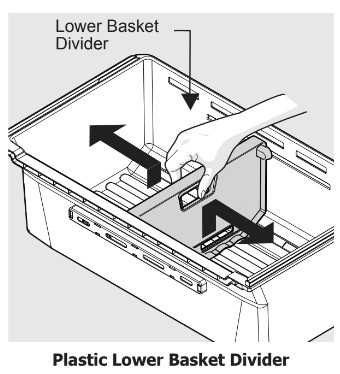
STORING FOOD AND SAVING ENERGY
1. Ideas for storing foods
Fresh food storage
• Keep the fresh food compartment between 34°F and 44°F with an optimum temperature of 37°F.
• Avoid overcrowding the refrigerator shelves, which reduces air circulation and causes uneven cooling.
• Avoid placing food in front of air ports. (See Controls Section for illustration.)
Fruits and vegetables
• Store fruits and vegetables in crisper drawers, where trapped moisture helps preserve food quality for longer time periods.
• Do not wash items until ready to use. Remove excess water before placing inside unit.
• Wrap any items that have strong odors or high moisture content.
Meat
• Wrap raw meat and poultry separately and securely to prevent leaks and contamination of other foods or surfaces.
• Use the Custom-FlexTM Temp Drawer to store meat/poultry for short-term storage. Any meat to be kept longer than two days should be frozen.
Frozen food storage
• Keep the freezer compartment at 0°F or lower.
• A freezer operates most efficiently when it is at least 2⁄3 full.
Packaging foods for freezing
• To minimize food dehydration and quality deterioration, use aluminum foil, freezer wrap, freezer bags, or airtight containers. Force as much air out of the packages as possible and seal them tightly. Trapped air can cause food to dry out, change color, and develop an off-flavor (freezer burn).
• Wrap fresh meats and poultry with suitable freezer wrap prior to freezing.
• Do not refreeze meat that has completely thawed.
Loading the freezer
• Prior to grocery shopping, activate “quick freeze” so newly purchased
food designated for the freezer will be preserved as quickly as possible.
• Activating “quick freeze” also will help the freezer more efficiently maintain the selected temperature after placing new purchases with pre-existing frozen foods.
• Avoid adding too much warm food to the freezer at one time. This overloads the freezer, slows the rate of freezing, and can raise the temperature of frozen foods.
• Leave a space between packages, so cold air can circulate freely, allowing food to freeze as quickly as possible.
2. Ideas for saving energy
Installation
• Locate the refrigerator in the coolest part of the room, out of direct sunlight, and away from heating ducts or registers.
• Do not place the refrigerator next to heat-producing appliances such as a range, oven, or dishwasher. If this is not possible, a section of cabinetry or an added layer of insulation between the two appliances will help the refrigerator operate more efficiently.
• Level the refrigerator so that the doors close tightly.
Temperature settings
• Refer to the “Controls” section for procedures on temperature settings.
Food storage
• Avoid overcrowding the refrigerator or blocking cold air vents. Doing so causes the refrigerator to run longer and use more energy.
• Cover foods and wipe containers dry before placing them in the refrigerator. This cuts down on moisture build-up inside the unit.
• Organize the refrigerator to reduce door openings. Remove as many items as needed at one time and close the door as soon as possible.
• Do not place a hot container directly on a cold shelf. Remember, such an extreme temperature change may damage the glass.
NORMAL OPERATING SOUNDS AND SIGHTS
Understanding the sounds coming from the refrigerator
High-efficiency refrigerators may introduce unfamiliar sounds. These sounds normally indicate the refrigerator is operating correctly. Some surfaces on floors, walls, and kitchen cabinets may make these sounds more noticeable.
The following is a list of major components in the refrigerator and the sounds they can cause:
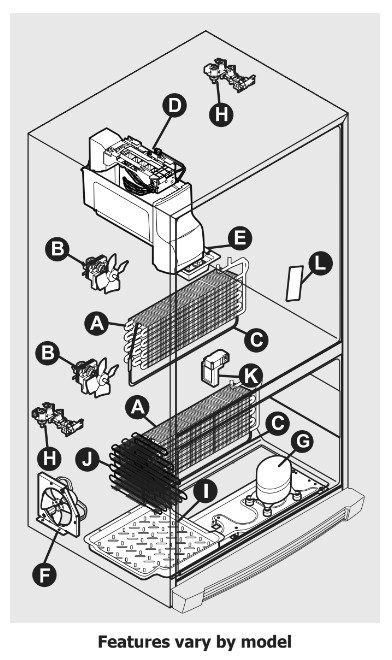
A Evaporators Refrigerant through the evaporators may create a boiling or
gurgling sound.
B Evaporator fans Sounds of air being forced through the refrigerator by the evaporator fans may be heard.
C Defrost heaters During defrost cycles, water dripping onto the defrost heaters may cause a hissing or sizzling sound. After defrosting, a popping sound may occur.
D Automatic ice maker When ice has been produced, sounds of ice cubes falling into the ice bin may be heard. Ice maker fan, water valve activation, and refrigerant gas fluid may create sounds from its operation.
E Electronic control & automatic
defrost control These parts can produce a snapping or clicking sound when turning the cooling system on and off.
F Condenser fan Sounds of air being forced through the condenser may be heard.
G Compressor Modern, high-efficiency compressors run much faster than older models. The compressor may have a high- pitched hum or pulsating sound.
H Water valves Make a buzzing sound each time they open to fill the ice maker. I Drain pan (not removable) Sounds of water dripping into the drain pan during the defrost cycle may be heard.
J Condenser May create minimal sounds from forced air.
K Motorized damper May produce a light humming during operation.
L Ice dispenser When dispensing ice, a snapping, clicking, or popping sound may be heard.
NOTE
- Energy efficient foam in the refrigerator is not a sound insulator.
- During automatic defrost cycle, a red glow in the back wall vents of the freezer compart-ment is normal.
CHANGING THE FILTER
Air Filter (select models)
The air filter is located in the top center of the fresh food compartment.
Replacing the PureAir Ultra II™ Air Filter
To ensure optimal filtering of refrigerator odors, change the air filter every six months (Replace
Air Filter on the Display indicates replacing the filter after six months).
1 Remove the air filter cover by squeezing the top and bottom of the cover together and removing from liner.
2 Remove the old filter and discard it.
3 Unpack the new filter and snap it into the filter cover. The open face (carbon media) of the filter should be installed facing outward in the cover.
4 Replace the air filter cover by squeezing the sides and snapping it back into place.
5 Press and hold the “Reset Air Filter” button on the Display for three seconds. When the indicator turns off, the status has been reset.
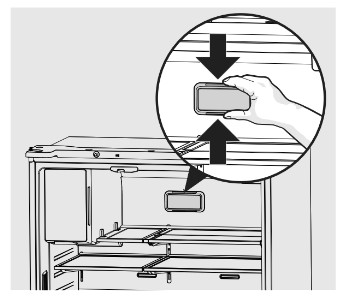
Water Filter
The refrigerator is equipped with a water filtering system. The water filtering system filters all dispensed drinking water, as well as the water used to produce ice. The water filter is located at the top right side of the fresh food compartment.
Replacing the Water Filter
Change the water filter every six months to ensure the highest possible water quality. Replace Water Filter on the display indicates when to replace the filter after a standard amount of water (125 gallons/473 liters for PureSource Ultra IITM) has flowed through the system.
If the refrigerator has not been used for a period of time (during moving for example), change the filter before reinstalling the refrigerator.
To Remove: Pull cover forwards and cover will drop down and allow access to filter.
To Reinstall: Push cover up towards liner and then push towards rear of cabinet. Filter cover will snap back into place.
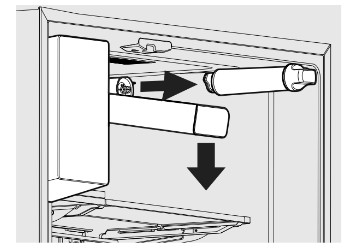
More about the Advanced Water Filter
 The PureSource Ultra II™ ice and water filter system is tested and certified to NSF/ANSI Standards 43, 53 and 401 for the reduction of claims specified on the performance data sheet.
The PureSource Ultra II™ ice and water filter system is tested and certified to NSF/ANSI Standards 43, 53 and 401 for the reduction of claims specified on the performance data sheet.
Do not use with water that is microbiologically unsafe or of unknown quality without adequate
disinfection before or after the system. Systems certified for cyst reduction may be used on disinfected waters that may contain filterable cysts.
Test & certification results:
• Rated Capacity - 125 gallons/473 liters for PureSource Ultra IITM ice and water
filter
• Rated service flow - .65 gallons per minute
• Operating Temp: Min. 33°F, Max. 100°F
• Maximum Rated Pressure - 100 pounds per square inch
• Recommended Minimum Operating. Pressure: 30 pounds per square inch.
To replace the PureSource Ultra II™ water filter:
It is not necessary to turn the water supply off to change the filter. Be ready to wipe up any small amounts of water released during the filter replacement. (Instructional video of procedure can be found on www.frigidaire.com.)
1 Push down on front edge of filter cover. Cover will tilt down and expose water
filter.
2 Remove the old filter by rotating it counter-clockwise (to the left) 90 degrees to release it.
3 Slide the old filter cartridge straight out of the housing and discard it.
4 Unpackage the new filter cartridge. Slide it into the filter housing as far as it will go with the grip end horizontal.
5 Push lightly inward on the filter while rotating it clockwise (to the right). The filter will then pull itself inward as it is rotated. Rotate the filter 90 degrees until it stops and the grip end is vertical. A very light click may be heard as the filter locks into place.
6 Press a drinking glass against the water dispenser while checking for any leaks at the filter housing. Any spurts and sputters that occur as the system purges air out of the dispenser system are normal.
7 Continue dispensing water for 3-4 minutes. It may be necessary to empty and refill the container several times.
8 Press and hold the Reset Water Filter button on the display for three seconds. When indicator is no longer illuminated, the water filter status has been reset.
9 Replace filter cover by pushing up and snapping into place.
CARE & CLEANING
Care & Cleaning Tips:
Keeping the refrigerator clean maintains its appearance and prevents odor build-up. Wipe up any spills immediately and clean the freezer and fresh food compartments at least twice a year.
NOTE:
1. Do not use abrasive cleaners such as window sprays, scouring cleansers, flammable fluids, cleaning waxes, concentrated detergents, bleaches, or cleansers containing petroleum prod-ucts on plastic parts, interior doors, gaskets, or cabinet liners. Do not use scouring pads or other abrasive cleaning materials.
- Never use metallic scouring pads, brushes, abrasive cleaners, or strong alkaline solutions on any surface.
- Never use CHLORIDE or cleaners with bleach to clean stainless steel.
- Do not wash any removable parts in a dishwasher.
2. When setting temperature controls to turn off cooling, power to lights and other electrical components will continue until the power cord is unplugged from the wall outlet.
- Always unplug the electrical power cord from the wall outlet before cleaning.
- Remove adhesive labels by hand. Do not use razor blades or other sharp instruments which can scratch the appliance surface.
- Do not remove the serial plate. Removal of the serial plate voids the warranty.
- Before moving refrigerator, raise the anti-tip brackets so the rollers will work correctly. This will prevent the floor from being damaged.
Refer to the guide on the next page for details on caring and cleaning specific areas of refrigerator.
CAUTION
• Pull the refrigerator straight out to move it. Shifting it from side to side may damage
flooring. Be careful not to move the refrigerator beyond the plumbing connections.
• Damp objects stick to cold metal surfaces. Do not touch refrigerated surfaces with wet or
damp hands.
IMPORTANT: When storing or moving refrigerator in freezing temperatures, be sure to completely drain the water supply system. Failure to do so could result in water leaks when the refrigerator is put
back into service. Contact a service representative to perform this operation.
Vacation and moving tips
1. Short Vacations
• Leave refrigerator operating during vacations of three weeks or less.
• Use all perishable items from refrigerator compartment.
• Turn automatic ice maker off and empty ice bucket, even if only away a few days.
2. Long Vacations
• Remove all food and ice if leaving for one month or more.
• Turn the cooling system off (see “Controls” section for location of On/Off button) and disconnect power cord.
• Turn water supply valve to closed position.
• Clean interior thoroughly.
• Leave both doors open to prevent odors and mold build-up. Block doors open if necessary.
3. Moving
• Remove all food and ice.
• If using a handcart, load from the side.
• Adjust rollers all the way up to protect them during sliding or moving.
• Pad cabinet to avoid scratching surface.
Care & Cleaning Tips
1. Interior & Door Liners
• Soap and water
• Baking soda and water
⇒ Use two tablespoons of baking soda in one quart of warm water. Be sure to wring excess water out of sponge or cloth before cleaning around controls, light bulb or any electrical part.
2. Door Gaskets
• Soap and water
⇒ Wipe gaskets with a clean soft cloth.
3. Drawers & Bins
• Soap and water
⇒ Use a soft cloth to clean drawer runners and tracks.
4. Glass Shelves
• Soap and water
• Glass cleaner
• Mild liquid sprays
⇒ Allow glass to warm to room temperature before immersing in warm water.
5. Exterior & Handles
• Soap and water
• Non Abrasive Glass Cleaner
⇒ Do not use commercial household cleaners containing ammonia, bleach or alcohol to clean handles. Use a soft cloth to clean smooth handles or exterior. DO NOT use a dry cloth to clean smooth doors.
6. Exterior & Handles (Stainless Steel Models Only)
• Soap and water
• Stainless Steel Cleaners
⇒ Never use CHLORIDE or cleaners with bleach to clean stainless steel. Clean stainless steel front and handles with non-abrasive soapy water and a dishcloth. Rinse with clean water and a soft cloth. Use a non-abrasive stainless steel cleaner. These cleaners can be purchased at most home improvement or major department stores. Always follow manufacturer’s instructions. Do not use household cleaners containing ammonia or bleach.
BEFORE CALLING
1. Automatic Ice Maker
Ice maker is not making any ice.
• Ice maker is turned off
⇒ Turn on ice maker. For the fresh food ice maker, press ice maker on-off button once.
• Refrigerator is not connected to water line or water valve is not open
⇒ Connect the unit to the household water supply and ensure the water valve is open.
• The water supply line is kinked
⇒ Ensure that the supply line does not kink when the refrigerator is pushed into place against the wall.
• The water filter is not seated properly.
⇒ Remove and re-install the water filter. Be sure to seat it fully into the locked position.
• The water filter may be clogged with foreign material.
⇒ If water dispenses slowly or not at all, or if the filter is six months old or older, it should be replaced.
Ice maker is not making enough ice.
• Ice maker is producing less ice than expected.
⇒ The ice maker will produce approximately 2 to 3 pounds of ice every 24 hours depending on usage conditions.
• The water filter may be clogged with foreign material.
⇒ If water dispenses slower than normal, or if the filter is six months old or older, it should be replaced.
• The water supply line is kinked.
⇒ Ensure that the supply line does not kink when the refrigerator is pushed into place against the wall.
• Water pressure is extremely low. Cut-off and cut-on pressures are too low (well systems only).
⇒ Have someone turn up the cut-off and cut-on pressure on the water pump system (well systems only).
• Reverse osmosis system is in regenerative phase.
⇒ It is normal for a reverse osmosis system to be below 20 psi during the regenerative phase.
Ice cubes are freezing together.
• Ice cubes are not being used frequently enough or interruption of power for prolonged time.
⇒ Remove ice container and discard ice. The ice maker will produce fresh supply. Ice should be used at least twice weekly to keep the cubes separated.
• Ice cubes are hollow (shells of ice with water inside). The hollow cubes break open in the bin and leak their water onto existing ice, which causes it to freeze together.
⇒ This generally occurs when the ice maker does not get enough water. This is usually the result of a clogged water filter or restricted water supply. Replace the water filter and if the condition still
occurs, check to see if the water valve is not turned on all the way or if there is a kinked water supply line.
2. Dispenser (Ice & Water)
Dispenser (Ice & Water)
• There is no ice in the bin to be dispensed.
⇒ See the “Ice maker is not making any ice” section.
• The refrigerator doors are not completely closed.
⇒ Be sure the refrigerator doors are completely closed.
• Dispenser paddle has been pressed too long and the dispenser motor has overheated.
⇒ The motor overload protector will reset in about three minutes and then ice can be dispensed.
Ice dispenser is jammed.
• Ice has melted and frozen around auger due to infrequent use, temperature fluctuations, and/or power outages.
⇒ Remove ice container, thaw, and empty the contents. Clean container, wipe dry, and replace in proper position. When new ice is made, dispenser should operate.
• Ice cubes are jammed between ice maker and back of ice container.
⇒ Remove ice cubes that are jamming the dispenser.
Dispenser will not dispense water.
• Water filter not seated properly.
⇒ Remove and reinstall the water filter. For
Puresource Ultra II, be sure to rotate it
to the right until it stops and the grip
end is vertical.
• Water filter is clogged.
⇒ Replace filter cartridge. Be sure to rotate it to the right until it stops and the grip end is vertical.
• Household water line valve is not open.
⇒ Open household water line valve. See CONCERN column AUTOMATIC ICE MAKER.
Water not cold enough.
• As warmer tap water goes through the filter and enters the water supply system, the chilled water
is pushed through to the dispenser. Once the chilled water is used up, it will take several hours to bring the freshly replaced water to a cooler temperature.
⇒ Add ice to cup or container before dispensing water.
Note: Only first 26 ounces are chilled.
Water has an odd taste and/or odor.
• Water has not been dispensed for an extended period of time.
⇒ Draw and discard 10-12 glasses of water to freshen the supply.
• Unit not properly connected to cold water line.
⇒ Connect unit to cold water line that supplies water to the kitchen faucet.
3. Opening/Closing Of Doors/Drawers
Door(s) will not close.
• Door was closed too hard, causing other door to open
slightly.
⇒ Close both doors gently.
• Refrigerator is not level. It rocks on the floor when moved slightly.
⇒ Ensure floor is level and solid, and can adequately support the refrigerator. Contact a carpenter to correct a sagging or sloping floor.
• Refrigerator is touching a wall or cabinet.
⇒ Ensure floor is level and solid, and can adequately support the refrigerator. Contact a carpenter to correct a sagging or sloping floor.
• Food/packaging is obstructing the door from closing.
⇒ Make sure there is no food/packaging blocking the doorway.
• Flipper mullion on left fresh food door is not in the correct position.
⇒ Ensure the flipper mullion is in the correct position to allow the door to close. (See Flipper Mullion section.)
Drawers are difficult to move.
• Food is touching shelf on top of drawer.
⇒ Remove top layer of items in drawer.
• Track that drawers slide on is dirty.
⇒ Ensure drawer is properly installed on track. Clean drawer, rollers, and track. See
Care & Cleaning.
4. Running of Refrigerator
Compressor does not run.
• Refrigerator is in defrost cycle.
⇒ This is normal for a fully automatic defrost refrigerator. The defrost cycle occurs periodically, lasting about 30 minutes.
• Plug at electrical outlet is disconnected.
⇒ Ensure plug is tightly pushed into outlet.
• House fuse blown or tripped circuit breaker.
⇒ Check/replace fuse with a 15 amp time-delay fuse. Reset circuit breaker.
• Power outage.
⇒ Check house lights. Call local electric company.
Refrigerator seems to run too much or too long.
• The variable speed compressor is designed to run 100% of the time except during the defrost cycle. At times it will run faster, such as after a defrost cycle.
⇒ It is normal for the compressor to run continuously except during defrost mode.
5. Digital Temperature Setting Display
Digital temperature displays an error
• Electronic control system has detected a performance problem.
⇒ Contact Electrolux Customer Care for assistance with any errors or codes flashing in the display by calling 1-800-374-4432.
6. Water/Moisture/Frost Inside Refrigerator
Moisture collects on inside of refrigerator walls.
• Weather is hot and humid.
⇒ The rate of frost buildup and internal sweating increases.
• Flipper mullion
⇒ Adjust flipper mullion. (See “To adjust the flipper mullion” in the Installation section.)
Water collects on bottom side of drawer cover.
• Vegetables contain and give off moisture.
⇒ It is not unusual to have moisture on the bottom side of the cover.
⇒ Both crispers contain an automatic humidity control, which should adjust automatically to the varying levels of moisture inside the drawer without creating additional condensation or drying out the air inside the crisper drawer, works with various types of produce. If excess moisture is noticed, check to verify humidity membrane is not damaged and replace as necessary.
Water collects in bottom of drawer.
• Washed vegetables and fruit drain while in the drawer.
⇒ Dry items before putting them in the drawer. Water collecting in bottom of drawer is normal.
7. Water/Moisture/Frost Outside Refrigerator
Moisture collects on outside of refrigerator or between doors.
• Weather is humid.
⇒ This is normal in humid weather. When humidity is lower, the moisture should disappear.
8. Food/Drinks in Fresh Food Compartment/Custom-Flex Drawer
Food is freezing.
• Temperature setting is too low.
⇒ Move the setting to a higher degree.
• Temperature sensor is covered by food (right side of fresh food area).
⇒ Allow space for air flow to the sensor.
• Food is covering the air ports.
⇒ Allow space between the air ports and the food.
9. Cold Drink Timer
Drinks are freezing.
• Temperature setting is too low.
⇒ Move temperature setting higher.
• Cold drink timer is set too long.
⇒ Reduce time of cold drink timer accordingly.
